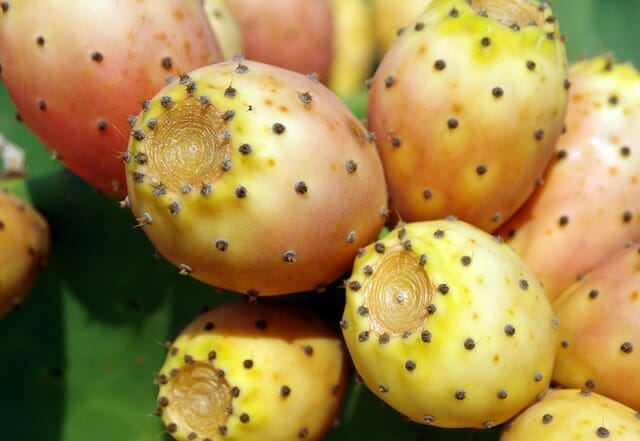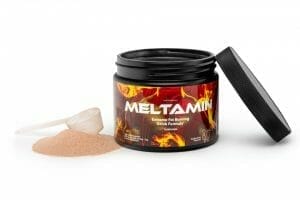Prickly pear (Opuntia ficus-indica) is an exotic Mexican fruit known for its health-promoting and slimming properties, as well as for its unique, captivating taste and remarkable appearance. Opuntia has a myriad of benefits – it exhibits antioxidant activity, normalizes blood sugar levels, boosts immunity, improves skin condition and slims the figure. Due to its ability to inhibit the absorption of fats from food, it is an ingredient in many capsules and pills for weight loss. Discover all the advantages of prickly pear!
Table of contents
- 1 Prickly pear – a peculiar fruit with valuable properties
- 2 What does the fruit of the prickly pear look like?
- 3 How can you tell when a prickly pear fruit is ripe and ready to eat?
- 4 What does the fruit of the prickly pear taste like?
- 5 Prickly pear – in what forms can it be bought?
- 6 Prickly pear fruit – nutritional values
- 7 Prickly pear – health properties
- 8 Prickly pear for weight loss
- 9 Use of prickly pear in cosmetics
- 10 How to consume prickly pear?
- 11 Prickly pear – cultivation
Prickly pear – a peculiar fruit with valuable properties

Pricklypear is one type of edible cactus. It is also sometimes called Indian fig, cactus fig, Indian pear, tuberous pear, mission pear. It belongs to the cactus family (Cactaceae) and is a succulent. The fruit of the prickly pear has a very sweet taste, while at the same time it is extremely juicy, thus providing the power of refreshment.
The prickly pear is native to Mexico, but is nowadays cultivated elsewhere, including South America, USA, Australia and Europe (including mainly Italy, Spain and Greece). Opuntia has a centuries-old tradition. It was already used in the country of the Aztecs, who appreciated both its food and health-promoting qualities. It is said to have been brought to Europe by Christopher Columbus.
Prickly pear is a typical thermophilic plant . It grows well in tropical, subtropical and semi-desert climates. It is not very tolerant of low temperatures.
The prickly pear is a sizable cactus, reaching up to 5 meters in height. It has the form of a shrub or a small tree. It is equipped with flattened stems covered with a hard, waxy skin. It grows numerous spikes about 2 cm long. They protect the plant from animals and too much water loss. Opuntia flowers bloom in summer, mainly in June and July. They have a pink hue, are very showy, large and showy.
What does the fruit of the prickly pear look like?
The fruit of the prickly pear is oval in shape, and its size is comparable to that of a kiwi, pear or lemon. On the outside it is covered with tiny protuberances. It can take on a variety of colors – from red, to orange and yellow, to green. Inside the fruit is red or yellow flesh with very numerous tiny seeds (they are eaten along with the flesh).
How can you tell when a prickly pear fruit is ripe and ready to eat?

The prickly pear fruit, like most fruits, has the best flavor when it is fully ripe, but at the same time still remains fresh, not old. How can you tell when a fruit is suitable for consumption? The easiest way is by the color. When a prickly pear has a greenish tint, it is still unripe, while when it has a vibrant yellow, orange or red color, it is ripe.
It is best to choose firm fruit with smooth, damage-free skin. If you purchase greenish fruit, you will have to wait until it is ripe. Avoid fruit that is damaged, covered with spots, too soft, and looks stale.
What does the fruit of the prickly pear taste like?
Prickly pear has a fractious exotic taste. It will certainly appeal strongly to any lover of tropical fruits such as kiwi, pineapple, pitaya, mango or pomegranate, but not only. In general, it is one of the tastier fruits in the world, so it tastes good to practically everyone.
In taste, prickly pear is distinctly sweet, but also captures a touch of palate-pleasing acidity. It is very juicy, which makes it refreshing and invigorating. The taste of prickly pear somewhat resembles that of grapes or watermelon. What is worth mentioning, the pear fruit has a very fleshy flesh, saturated with fiber, thanks to which it provides a feeling of satiety for a longer period of time. And due to the high water content of the flesh, it effectively quenches thirst.
Prickly pear – in what forms can it be bought?
All the above-ground parts of the prickly pear are edible – the leaves, flowers, but especially the fruit. Prickly pear extracts find their way into numerous dietary supplements and cosmetics. Fresh prickly pear fruit can also sometimes be found in stores. They can be eaten raw or added to dishes.
Other prickly pear products are also available for sale: prickly pear jam, dried prickly pear flowers, dried prickly pear leaves, prickly pear seed oil, candied prickly pear, prickly pear teas, and prickly pear powder.
Prickly pear fruit – nutritional values
Prickly pear not only captivates with its appearance and pleases with its taste, but also fills our body with valuable substances, among which numerous minerals, vitamins and compounds that play the role of antioxidants lead the way. 90% of the fruit of the Indian fig consists of water, the rest is made up of substances valuable to our health.
The fruit of the prickly pear contains:
- dietary fiber (including a lot of fiber of the soluble fraction, and in it pectin and beta-glucans),
- protein,
- amino acids,
- unsaturated fatty acids,
- simple carbohydrates (glucose, fructose),
- vitamin C,
- B vitamins,
- vitamin E,
- vitamin A,
- potassium,
- calcium,
- phosphorus,
- magnesium,
- manganese,
- iron,
- sodium,
- silicon,
- copper,
- tannins,
- flavonoids,
- carotenoids,
- beta-cyanins,
- organic acids,
- terpenes,
- sterols.
Prickly pear – health properties
Cactus pear, although it contains a lot of sugars, has a low glycemic index, so it can be successfully consumed by people with diabetic problems. Not only does it not harm diabetics, but also serves their health. By slowing down the digestion of carbohydrates, it counteracts sudden spikes in blood sugar. However, the health-promoting properties of prickly pear are not only normalizing glucose-insulin metabolism, but much more.
Why you should reach for prickly pear:
- stimulates the pancreas to secrete insulin, reduces insulin resistance, helps normalize blood glucose levels,
- has an effect on lowering blood cholesterol levels, thus reducing the risk of cardiovascular disease,
- thanks to its high concentration of antioxidants, delays the aging process, protects cells from reactive oxygen species and reduces the risk of cancer and neurodegenerative diseases,
- improves digestive processes, counteracts bloating, indigestion, constipation,
- has a diuretic effect, stimulates the purification of the body from toxins,
- supports the liver,
- positively influences the body’s immunity,
- fights inflammation, helps overcome fungal and bacterial infections faster,
- applied externally, it alleviates rheumatic pains, stimulates the wound healing process, fights skin infections.
Prickly pear for weight loss

Indian fig is an apt choice for those seeking to reduce weight. It is a low-calorie fruit and has a low glycemic index, while being very filling. It is a great patent for snacking in moments of hunger and a tasty addition to snacks, smoothies and meals. It is also helpful in removing excess water from the body that causes body swelling.
Opuntia improves carbohydrate metabolism and counteracts blood sugar fluctuations. It prevents attacks of ravenous hunger and excessive craving for sweets. Its frequent use will certainly help us keep our appetite in check and reduce the number of calories we consume. It also plays a significant role in the metabolism of fats – it reduces their absorption in the digestive tract and stimulates their excretion from the body.
Opuntia extracts are included in many fat reducers for good reason. Accelerating the body-slimming process, prickly pear simultaneously replenishes vitamin and mineral deficits that can occur with the introduction of a weight-loss diet.
Meet the powerful fat burner with prickly pear: Meltamin
Use of prickly pear in cosmetics
Prickly pear is rich in beneficial organic acids and vitamins such as vitamin E, A, C, B vitamins. It also has anti-inflammatory effects, soothes irritation and regenerates the skin. It exhibits antioxidant properties, thanks to which it protects the skin from free radicals and inhibits aging.
Its rich composition makes prickly pear extracts and prickly pear oil very popular as an active ingredient in cosmetics, including: creams, lotions, soaps, face serums, body butters, hydrolats, shower gels, shampoos.
Prickly pear, whether used in cosmetics or in the form of oil applied directly to the skin, improves the skin in multiple ways. It improves skin hydration and nutrition, reduces wrinkles, including facial wrinkles, has a smoothing effect, and makes the skin look more radiant and vital.
How to consume prickly pear?
We can eat it raw (getting rid of the skin beforehand) or add it to dishes, drinks and desserts. Among other things, prickly pear will work phenomenally as an ingredient in:
- Mexican dishes,
- fruit salads,
- jellies,
- ice creams,
- cheeses,
- oatmeal,
- preserves, such as jams, juices,
- yogurts,
- desserts,
- omelets, pancakes,
- blender smoothies.
Prickly pear – cultivation

The prickly pear does not have high soil requirements, but it grows best in sandy loam soils. It is a thermophilic plant and prefers a high degree of sunlight. Therefore, it naturally occurs primarily in countries with warm climates. In our climate it does not occur in nature. However, if we want, we can grow prickly pear at home.
For home cultivation of prickly pear, it is worth choosing a low and wide pot with holes in the bottom. Keep in mind that it is essential in growing prickly pear to ensure proper drainage. Water must not stand in the pot, but drain freely. The soil should be permeable, light, sandy, with special soil for cacti working best. Water sparsely and rarely, when you notice that the soil is quite dry. Too frequent watering can result in root rot and death of the plant.
Opuntia should be fertilized 1-2 times a month with fertilizer for cacti. As for the position for the prickly pear, it is best to put the plant in a sunny, warm place, such as near a south or west window. If we care about the flowering and fruiting of the plant, it is essential to provide it with an abundance of sunlight. To make the prickly pear grow better, during the winter season it is worth providing the plant with a resting period, placing it in a bright, but fairly cool room (the minimum temperature is 8-10 degrees).
Sources:
- https://pubmed.ncbi.nlm.nih.gov/33670110/
- https://www.healthline.com/health/about-prickly-pear-seed-oil
- https://www.webmd.com/diet/health-benefits-cactus-fruit
- https://pubmed.ncbi.nlm.nih.gov/25232708/
- https://pubmed.ncbi.nlm.nih.gov/35780308/


